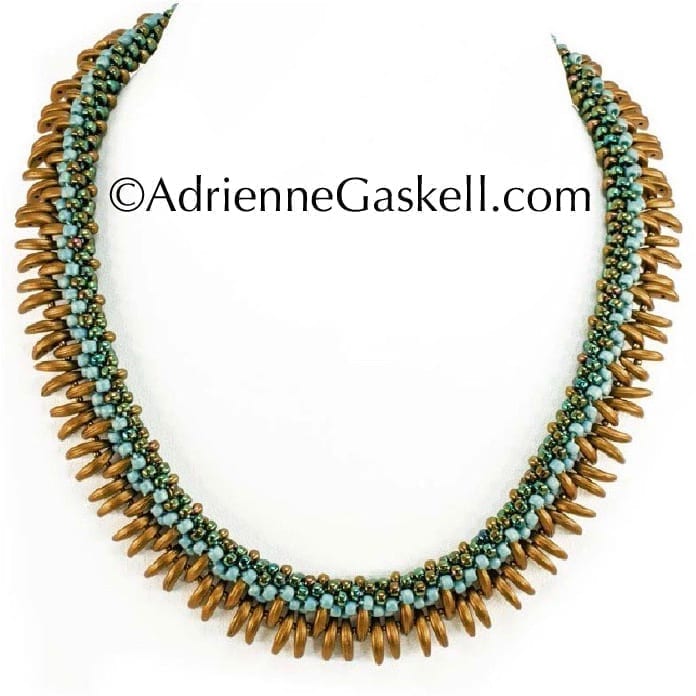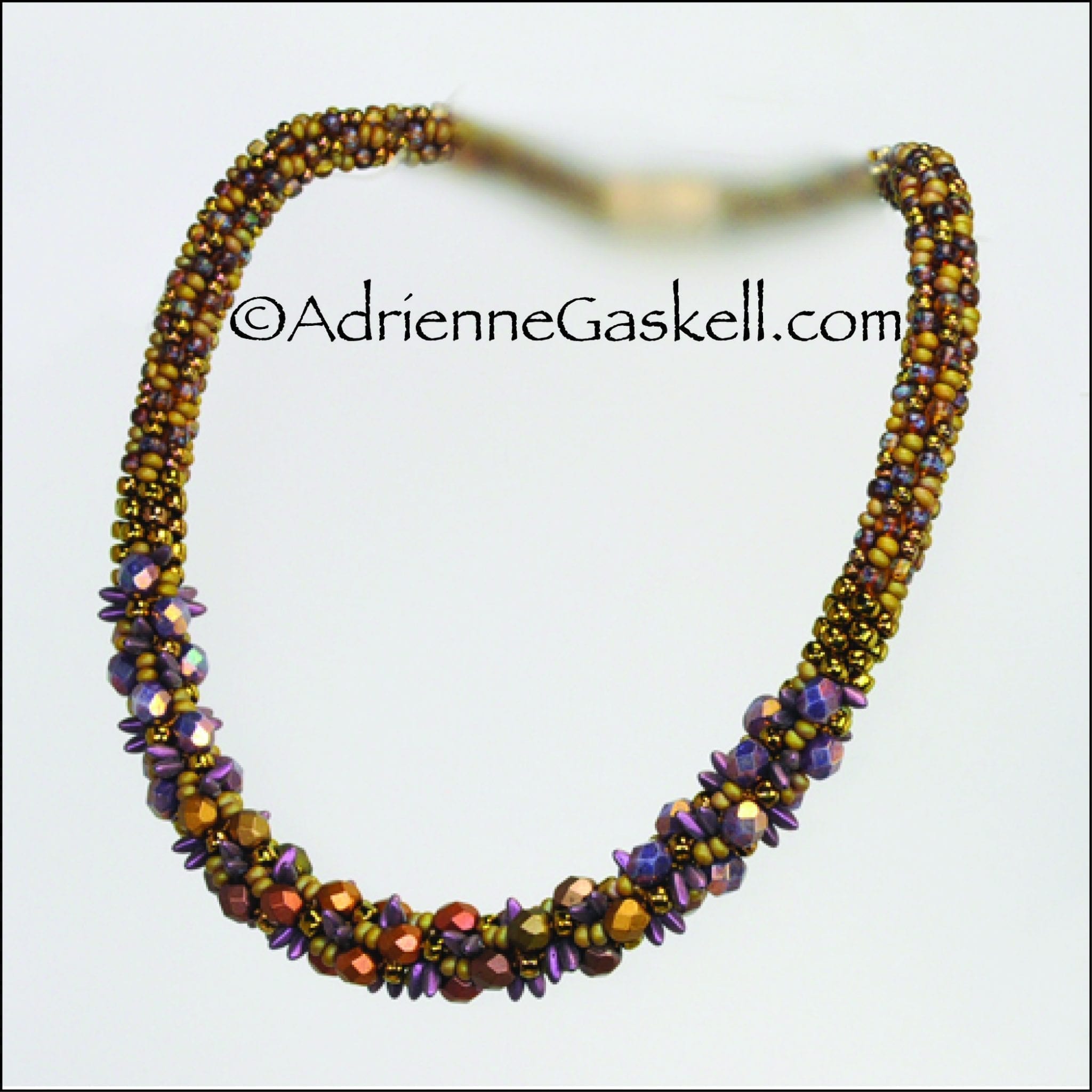Author: Adrienne Gaskell
Braid Documentation & Downloadable Forms
Simple Documentation Whether or not you intend to replicate the braid you are making, keeping notes can help you plan another similar project in the future. There are many ways to document a braid as well as some useful apps that can be downloaded to your phone or tablet. These are some of the things I like to use to keep track of my projects. Kongoh Beaded Braid with Counted Bead Pattern The Bead Layout Blank is used keep a record of the bead placement when making a counted pattern. You should also make notes of your cord length, type of cords, and necklace length. See example of how to use the Bead Layout Blank. I attached a photo for easy reference.
Braiding Around a Core – Disk or Marudai
Reprint from Bead & Button Magazine, April 2017 Updated January 2021 Cores are often used to prevent a beaded braid from collapsing. A braid may collapse when braiding with larger than size 8º seed beads. Larger beads will create a larger hollow space on the inside of the braid causing the braid to collapse and not have a firm round appearance. A core can be used to fill the hollow core space and keep the braid round. A beaded kongoh braid (round braid) may develop a hollow space if: • The braid is made up of mostly 6º or larger seed beads. These beads have large holes so usually the warp cord will fill only a small portion of it causing the beads to be pushed to the outside of the braid, leaving a large hollow space inside of the braid. Using a heavier warp cord or a doubled warp cord can solve the problem. Or a core can be used to solve the problem. • The braid is made with mostly gemstone beads or pearls. Since these usually have very small holes, a thin warp cord or beading wire is used to string the pearls or gemstones. The combination of large beads and a thin warp cords causes a large hollow inside the braid. • The braid is made with 12 or 16 strands of beads. These braids will have a larger outside diameter than an eight-strand braid which will create a larger hollow space in the braid. WHAT TO USE FOR A CORE Many materials can be used as a core; soft cording, rattail, yarn, tubing and t-shirt ribbon, to name a few. Generally a good size is about 2mm thick as it can be used single or in multiple layers when a thicker core is needed. It is a good idea to use a core that is made of nylon when braiding with SLon and CLon as it will be safe to use with a Cord Zapper. The thickness of the core will vary depending on what beads and cords are used in the braid. It may be necessary to test different core materials to determine what works best for a particular braid. Some materials can be used in multiple thicknesses to achieve the desired core thickness. Don’t be afraid to experiment. Braid a section and see if it feels right. If the core is too thin then the braid will feel squishy. Look at the braid. If the core is too thick the warp cords and/or the core will be obvious and visible. If necessary unbraid back to the beginning and adjust the core thickness. HOW TO START A CORE If using SLon or CLon simply tie the core in with the fiber knot at the beginning of the braid. The core needs to be least 6 in. (15 cm) longer than the finished braid length. In the photo above the core is being used double. A core can be added after the cords are setup on the disk or marudai. Simply tie the beginning of the core around the cord knot or the split ring at the beginning of the braid. MARUDAI – BRAIDING WITH A CORE There are several ways to manage the core and keep it out of the way while braiding. You can clip it to your shirt or wrap the end of the core on a plastic bobbin and drape it around your neck. It can also be hung above the marudai from a ceiling fan, overhead lamp or, if you have one, you can use core stand. The last photo is of Mo Perry’s Core Stand Hack using a light weight tripod, piece of PVC and velcro straps to hold the PVC to the tripod. If you need to extend the length of the core in order to reach the overhead object, simply tie a long length of SLon (or other cord) to the end of the core. Then wrap the loose end of the SLon onto a plastic bobbin. Hang the bobbin over the overhead object. The weight of the bobbin will keep a slight tension on the core allowing it to move easily while braiding . Braid as usual. At the beginning, when braiding the nub without beads, it may be necessary to pull on the core to get it neatly positioned inside the unbeaded braid nub. When finishing the braid end as usual, leaving the core in place while braiding the unbeaded braid nub. If using a nylon core with CLon or SLon the braid ends can be burned off and sealed with a Cord Zapper. DISK – BRAIDING WITH A CORE To keep the core in the center of the braid and out of the way when working on a disk simply flip the core to the opposite side of the disk from where the warp cords are being worked. Start with the core positioned on the left of the point of braiding, move the upper-right warp into position. Flip the core from left to right, and move the lower left warp into position. Rotate the disk, and repeat. Wrap the end of the core onto a plastic bobbin to make it faster to move the core from side to side. Link to: What is a Core Gizmo™?
How to Make a Core Gizmo™
WHAT IS A CORE GIZMO™? This handy tool is one of my favorite inventions! My husband, Carl, makes these for my students when I teach in-person classes. They are really useful for braiding on a marudai when there is no way to hang the the core overhead. If you are not lucky enough to have received one of Carl’s Core Gizmos™ here are instructions for making your own Core Gizmo®. Cut a 12 in. to 18 in. (30 – 45 cm) piece of wire. Wrap one end of the wire around a dowel or mandrel to make a double wrapped loop. I recommend using 20 or 22 gauge stainless steel wire as the diameter will be thin enough not to impact the diameter of the braid. f using copper I recommend 18 gauge otherwise it will not be sturdy enough to stand up on its own. BRAIDING WITH THE CORE GIZMO™ Insert the straight end of the Core Gizmo™ into the point of braiding so that about 2 to 3 in. (5 to 7.5 cm) of the end is below the mirror. Tape the end to the counter weight so that the Core Gizmo™ is upright as shown in photo. Bring the core up to the top of the Core Gizmo™ and thread it through the loop on the end of the Core Gizmo™. It may need to be looped through a couple of times to keep the core out of the way. Start braiding. Once there is about two inches (5 cm) of braid remove the tape that is holding the Core Gizmo™ to the counter weight. The braid should now be able to support the Core Gizmo™ so that it will stand upright on its own. As the braid length progresses periodically pull up the Gizmo. There should not be more than about two inches (5 cm) of the Core Gizmo™ inside the braid. If the core gets too short during braiding tie another piece of core to the end to add enough working length so that it can be threaded through the loop. Also, when the core gets short you can add a piece of tape to the end to keep it from slipping out of the wire loop. When near the end of the braid a short core can be taped to the Core Gizmo™. NOTE: The Core Gizmo™ will make the unbeaded braid nub fatter than if it is not used. This may be important depending on the clasp that will be used for the braid. Before starting the braid, determine the inside diameter of the clasp. Once the if unbeaded nub is braided, check to be sure it will fit in the clasp. If not, braid the unbeaded nub without using the Core Gizmo™.
Two Part Epoxy – How to Securely Glue on Clasps
Two part epoxy is the only glue that creates a permanent bond and it is the only glue recommended by professional jewelers. These step-by-step instructions ensure success and remove all of the guess work. What Brand Should you Buy? All brands work and are basically the same. However I like the epoxy that comes in stand up plastic bottles as they will stay cleaner than tubes. The bottles prevent the glue from oozing out, whereas the tubes get messy very quickly. The double syringe dispensing styles seem like a good idea to get equal amounts from each tube but they often don’t dispense equally and it is difficult to adjust the amounts when they don’t work correctly. The stand up bottles can be a bit more expensive than others, about $18 at Home Depot, but it will probably last you for several years. One tube will be labeled Resin and the other Hardener. Even though Hardener appears to be yellow, that is just so you can tell them apart, it will dry clear. Be sure not mix up the caps, or they will get glued on permanently. I recommend using epoxy with a 5 minute setting time. This should give you about two to three minutes of working time before the epoxy starts to set up. Which should be plenty of time even for a novice. Choosing a Clasp Choose a clasp with a similar outside diameter as the braid. The braid does not need to fill the entire opening of the clasp opening. This is one of the advantages of 2-part epoxy, it forms a secure bond between the clasp and the braid nub even when there is empty space inside the clasp. This removes the extra work of binding the end of the braid. When gluing a clasp on a beaded braid, only the un-beaded nub should be glued inside the clasp opening, no beads need to be inside the clasp. Do a Dry Fit Check to see if the braid end fits into the clasp opening. The braid nub should not be visible. If it is a beaded braid the beads should be snugged up against the clasp. If necessary trim or shorten the braid nub. Make Friends with Gravity The secret to keeping glue inside the clasp and not on the braid is to use gravity to your advantage. If the clasp opening is pointed upward gravity will keep the epoxy inside the clasp. But be sure not to use too much epoxy or the braid nub will push epoxy out of the clasp opening and make a mess. If the magnet is flush with the bottom of the clasp, you can place it on something metal, like a jewelers bench block as shown in photo. The magnet will attach firmly to the metal and keep it from sliding around while you are working. Also, find a way to keep the braid will need to be suspended above the clasp. A set of third hand tweezers work well. Sometimes a plastic bobbin can be used, simply place the clasp in the center hole. For other types of clasps a small jeweler’s vise is a handy tool to have. A small clamp on bench vise can be purchased at RioGrande.com for about $14.00. A chopstick or a dowel can be inserted into the vise jaws with the clasp and be used to hold the braid upright. Simply use painter’s tape to attach the braid to the chopstick to hold the braid upright while drying. Get Ready Have all supplies ready: • The braid and clasp • The epoxy • A plastic bag, this should be large enough to dispense and mix the epoxy, a good use for used plastic bags. I don’t recommend using aluminum foil as it can easily tear when you are mixing the epoxy. • A couple of toothpicks • A paper towel or rag without a pile, a T-shire rag is perfect. Gluing Until you get comfortable using epoxy I strongly recommend that you glue one side of the clasp and let it set up for about an hour before gluing the other side. I know you will want to use up all that epoxy once you have mixed it up but it is not worth messing up your project for a few cents worth of epoxy. You have invested a lot of time in your project, now is not the time to be impatient. Get the braid and clasp set up and ready. Dispense equal amounts of epoxy from each tube. Keep them apart from each other. Let sit for several minutes and allow to settle. As long as the two parts are not touching or mixed together, the epoxy can sit for a long time. After it has settled it is easier to see if both amounts are equal. If you are not sure, err on the side of more hardener than resin. Use a toothpick and mix both parts together until they are well blended. The mixture will become a solid color. Using the same toothpick and add the epoxy to the inside of the clasp opening filling about half way. Distribute some of the epoxy up the sides of the clasp. The amount of epoxy needed will depend on the size of your braid nub. If the braid nub is not a uniform shape a small amount of epoxy can be added to the braid nub to ensure even coverage. Fill the clasp opening about half way and spread epoxy all the way up the sides. Insert the braid end into clasp opening. If necessary remove braid end to either add or take out some of the epoxy. If you have too little epoxy you will not get a secure bond. Too much epoxy will force glue out of the clasp and into the beaded braid. Reinsert the braid nub and firmly hold the braid in place while applying downward pressure for several minutes. Once the braid is secured in the clasp you can let go. I know it is ready to be released when the braid does not move when I release my grip. Use the rag or paper towel and immediately wipe off any excess glue from the outside of the clasp and braid. Don’t make the mistake of thinking you can remove epoxy later, it is permanent! Let braid stay in position for about one hour while the epoxy sets. Follow steps 1 – 8 and glue the other end of the clasp. It will take 24 hours for the epoxy to cure so wait until tomorrow before you wear your new piece of jewelry. Sometimes it is possible to glue both ends at the same time using the same mixture of epoxy. However, I do not recommend this until you become proficient using epoxy. It is worth spending a few cents on the extra glue to have a professional looking finish for your project.
Kumihimo Wednesdays
Wednesday evenings at 7pm ET Adrienne hosts a live Zoom meeting and shares topics of interest to kumihimo enthusiasts of all levels of experience. Learn Adrienne’s innovative techniques and tips through instructional presentations and live demonstrations. Special guests also share their knowledge and expertise. *A Zoom account is required (free or paid) to attend Kumihimo Wednesdays with Adrienne Kumi-U Club – All Access Pass – $20 monthly – or – $200 annually Invitation to all Kumihimo Wednesday live Zoom meetings Access to past Zoom meeting recordings* – Never miss a meeting Priority Registration – Kumi-U Classes with limited seating First Option on Limited Edition Kits by Adrienne Gaskell Art Jewelry *Access to Zoom meetings and recordings during valid membership period. Kumi-U Club – Guest Pass – Free* Invitation to First Wednesdays with Adrienne Email notifications: Classes, kits and new products *No purchase necessary. Create a free KumihimoResource.com account. a la carte – $8 each Zoom recording of past* Kumihimo Wednesdays with Adrienne *Some meeting recordings may only be available to Kumi-U Club All Access Pass holders What are First Wednesdays On the first Wednesday of the month Adrienne Gaskell hosts a live Zoom meeting to share information of interest to kumistas of all levels of experience and interest. Techniques and tips from these meetings can be found on the KumihimoResouce.com Technique Tips page. Some Past Topics: • Toho Beads Virtual VIP Factory Tour with Iwao Yamanaka (President) and Rochelle Peterson, Bobby Bead Company • INSPIRATION – Techniques That Inspire Creativity • Braiding Around a Core – Why & When is a Core Necessary • Is a Disk a Baby Marudai? • Japanese Fibers 101 – How to work with pre-cut kumihimo fibers • Over the Rainbow Bracelet instructions, bonus Caterpillar Bracelet pattern • Maureen Shankey Studio Tour & Jewelry Sale • Melange des Perles instructions with student variations • Beaded Braids – Perfect Fit Every Time Hope to see you soon!
Project Tutorials Now Available
Exclusive project patterns as well as ones that have been featured in Bead & Button and Beadwork Magazines will be released throughout the year. Most of the tutorials that were previously featured in the magazines are expanded versions of what was previously published. Some of the enhancements include: • Instruction for both the round disk and the marudai • More details and photos • Adrienne’s exclusive tips • Shortcuts and more Project Tutorials Prices Free – Kumi-U Club All Access Annual Pass, $200 annual membership $10 each – Kumi-U Club All Access Monthly Pass, $20 monthly membership $20 each – Kumi-U Guest Pass, Free membership A limited number of kits will be offered when new tutorials are released. Scheduled for 2021:
Melange des Perles Necklace
This content is only available to course members. Login to your account or enroll into the course to see content.








